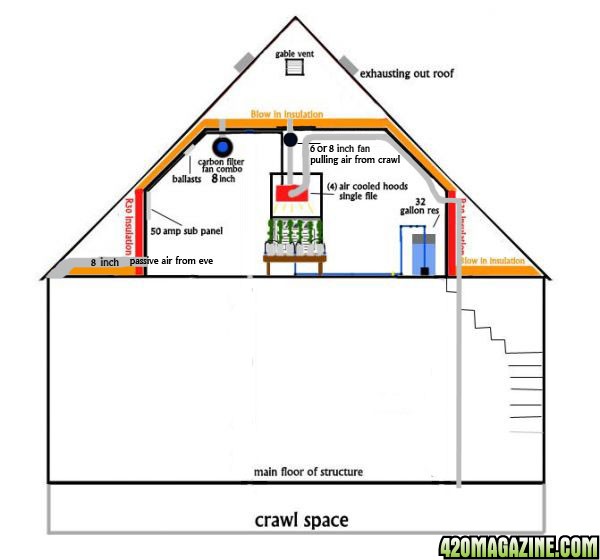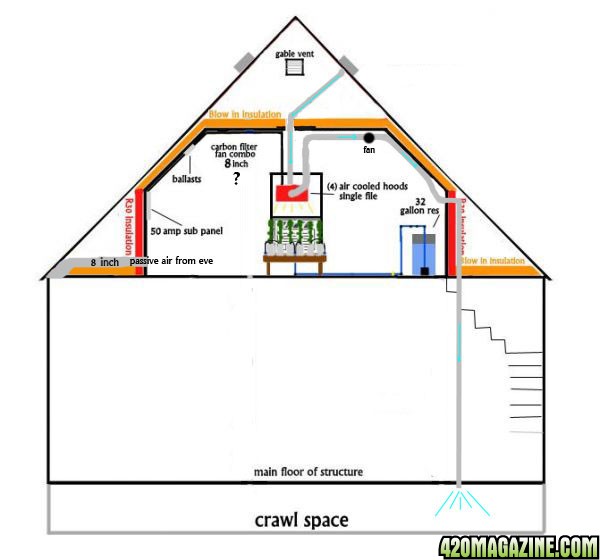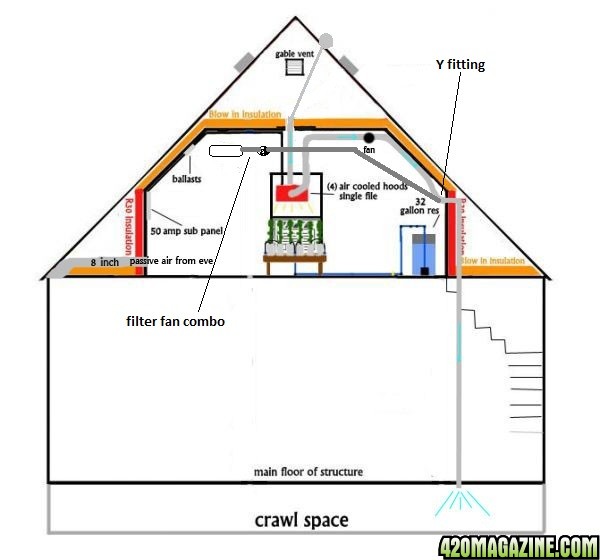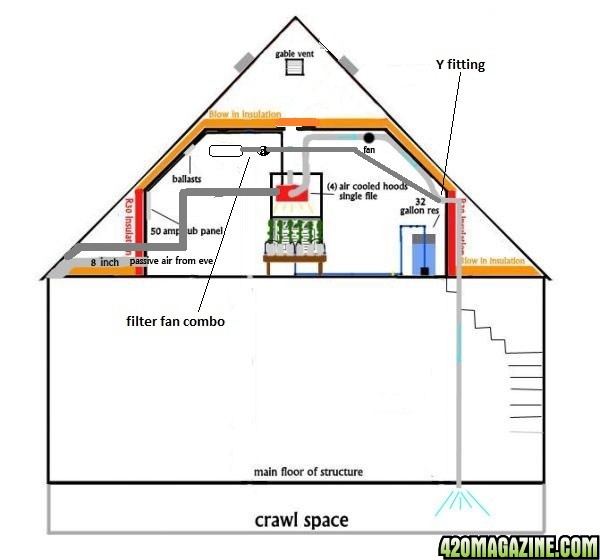SmokzAlot
New Member
I will postulate, if you could create a lung in the attic space it may work well.
Although creating on the same level as the grow room would be more convenient to service and such. A walk in foyer if you will is large enough. Also could serve as a central control area and supply area. By restricting your grow space to something relevant to the foot print of your lighting, and then applying a reflective surface will exceed what an open room will produce, as far as how much light is effectively reaching the plants. These interior walls could easily be constructed of poly board as well and perhaps some 2"x2" studs. Changes and/or alterations again being very simple if desired.
Some basic logic as I see it:
To apply any insulation on or near the roofing is not advised. It needs free circulation of air and to be the same temp or cooler as outside for longest roof life span. Hence eave vents and ridge vent. Or in you case gable vents.
The extreme temps of attics are death to a roof by severely shortening it's lifespan. This refers to the roofing materials and the framing under it. Humidity as well is no good in any form. Humidity reduces the effectiveness of your insulation big time first of all. Hence the vapor barrier on the proper side. We won't go into the potential for mold and mildew spores to grow and possibly infect your garden. Another similar example is if one draws dirty air from under the house. Dark dank area ripe for mold and mildew. By having a lung you are able to condition and clean air for your grow room. You may be able to create a lung of sort by applying a polystyrene sheeting to the lower side of the roof rafters and other interior structure, there by leaving a free ventilated space above it. Where this lung vents to the outside can be where ever it needs to be as well. By making your setup modular in design as such, you are open to expansion and change with less effort. Also impacting less of your garden as change or occurrences happen, as you are isolating environments as well.
Only you know what your goals are and potential future plans if any. I always opt for versatility to allow for life's changes. Not to mention Keep it Simple as well. But it MUST get the job done.
Always good to see people put some thinking into a project.
 DIY
DIY
Although creating on the same level as the grow room would be more convenient to service and such. A walk in foyer if you will is large enough. Also could serve as a central control area and supply area. By restricting your grow space to something relevant to the foot print of your lighting, and then applying a reflective surface will exceed what an open room will produce, as far as how much light is effectively reaching the plants. These interior walls could easily be constructed of poly board as well and perhaps some 2"x2" studs. Changes and/or alterations again being very simple if desired.
Some basic logic as I see it:
To apply any insulation on or near the roofing is not advised. It needs free circulation of air and to be the same temp or cooler as outside for longest roof life span. Hence eave vents and ridge vent. Or in you case gable vents.
The extreme temps of attics are death to a roof by severely shortening it's lifespan. This refers to the roofing materials and the framing under it. Humidity as well is no good in any form. Humidity reduces the effectiveness of your insulation big time first of all. Hence the vapor barrier on the proper side. We won't go into the potential for mold and mildew spores to grow and possibly infect your garden. Another similar example is if one draws dirty air from under the house. Dark dank area ripe for mold and mildew. By having a lung you are able to condition and clean air for your grow room. You may be able to create a lung of sort by applying a polystyrene sheeting to the lower side of the roof rafters and other interior structure, there by leaving a free ventilated space above it. Where this lung vents to the outside can be where ever it needs to be as well. By making your setup modular in design as such, you are open to expansion and change with less effort. Also impacting less of your garden as change or occurrences happen, as you are isolating environments as well.
Only you know what your goals are and potential future plans if any. I always opt for versatility to allow for life's changes. Not to mention Keep it Simple as well. But it MUST get the job done.
Always good to see people put some thinking into a project.
 DIY
DIY





